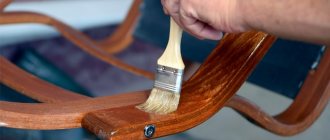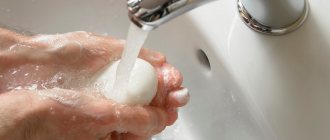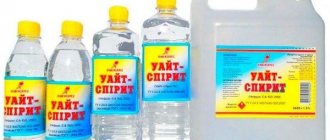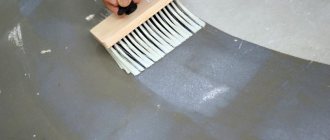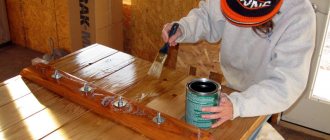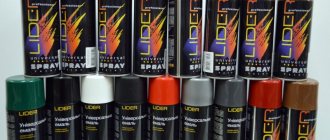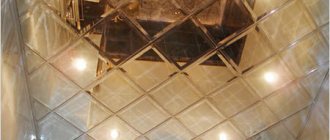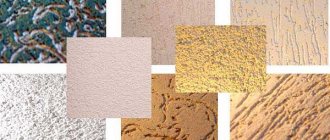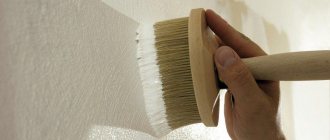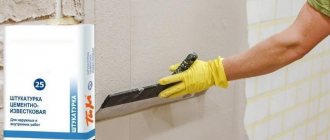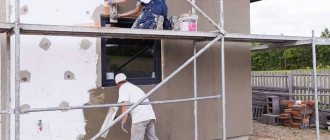What does the base of parquet varnishes say?
The main difference between these groups of varnishes is the base itself, as is clear from the name: in water-based parquet varnishes the base is water, in others - different types of solvents, for example, alcohols, acetone, white spirit (white spirit) or some acidic components.
Obviously, water is the most harmless component of all of the above. Next comes alcohol - the least harmful. But acidic environments can be harmful to humans. So from the point of view of the environment and your health, it would be safest to buy water-based parquet varnish. It has virtually no odor during work, is harmless to the artist at the time of applying the varnish and to people nearby, and is also absolutely safe after complete drying - zero emissions of harmful substances into the air, i.e. the client can easily exist in this climate.
Solvent-based varnishes have a very unpleasant odor, which is noticeable during the work. They can be harmful to the performer himself, to people who are in the premises while the work is being performed, as well as after the work for several days and sometimes even weeks. Even if the varnish film has already dried, it continues to evaporate the remaining harmful components: during operation, small, but constant emissions of harmful substances from solvent-based varnishes are possible.
So our clear recommendation is to buy water-based parquet varnish to cover parquet in residential premises.
Parquet adhesives and primers
The choice of adhesive is as important as the choice of parquet itself. Because it is from high-quality and correctly selected
The adhesive primarily determines the service life of the parquet.
How to choose parquet adhesive?
Dozens of factors are taken into account here: the type of wood, the dimensions of the die, the expected load on the floor, the type of base, operating conditions, etc. It is also important to take into account the characteristics of the glue: the strength and elasticity of the seam, the life time (the period during which the glue retains its strength), working time (the period during which the glue must be applied), noise insulation and vapor barrier parameters, density, and environmental friendliness.
Specific gravity (density) of glue
is an important parameter. It shows the consumption per unit area. It happens that the buyer only took into account the price per kilogram, but it turned out that the consumption of cheap glue was so high that more expensive glue would have been much more profitable.
Parquet adhesives are divided into 3 large groups:
- Water-dispersion adhesives
- Solvent based adhesives
- Polyurethane adhesives
1. Water-dispersion adhesives
contain water, which contributes to warping of the wood, so they are used only when working with small-format piece parquet made of stable species (oak, ash, hornbeam, birch). Their main advantage is price.
Kiilto
Bona
Ibola
2. Solvent adhesives
more universal than water-dispersible ones, they are suitable for almost all types of wood, but have a short working time, are low-elastic, and are accompanied by a pungent odor.
Stauf
Uzin
Ibola
3. Polyurethane adhesives
- this is the result of modern technologies, they have the best characteristics and are not accompanied by the release of harmful substances, but are more expensive.
two-component
one-component
polymer
— Two-component polyurethane adhesives
Suitable for any type of wood, size of dies, installation method and type of base. In addition, two-component adhesives have the strongest strength characteristics, so it is suitable even for laying solid boards of any size.
— One-component polyurethane adhesives (silane)
Also suitable for any type of wood, installation method and type of base. The strength of the adhesive seam is somewhat lower than that of a two-component glue, so there are limitations for very wide (from 150 mm) and long solid board dies. But one-component adhesives have a long life and high elasticity, so professionals use it to lay parquet without plywood, directly on a concrete base. It differs from two-component adhesives in its long working time, ease of use and low consumption.
— Polymer polyurethane adhesives
Also suitable for any type of wood, installation method and type of base. The main advantage is the increased elasticity of the adhesive seam, therefore the highest noise insulation rates. Increased elasticity is achieved by reducing the strength of the adhesive joint, so this glue is mainly used when laying parquet boards and engineered parquet directly on the screed.
DO NOT say “this glue is good, but this glue is bad”! The choice of glue must be approached individually, after analyzing all the factors that we mentioned at the beginning of the section.
Primers
They are divided into 4 categories: water-dispersion primers, solvent-based primers, polyurethane and epoxy. Their main purpose is to prepare the base for maximum adhesion (adhesion) to the glue. It is important to understand that the choice of primer directly depends on the type of adhesive chosen. Polyurethane glue requires a polyurethane or epoxy primer, water-based glue requires a water-based primer, and solvent-based glue works better with a solvent-based primer. In the parquet industry, there are no universal primers for all cases.
Dry residue
When choosing a varnish for parquet, you should also pay attention to the dry residue.
- High-quality water-based varnishes from good manufacturers, as a rule, have a dry residue in the range of 30 to 35%.
- Solvent-based varnishes, as a rule, have a larger dry residue and therefore form a thicker protective film. But this does not mean at all that such a film will protect better, because not only thickness is important, but also quality - i.e. how durable the film will be in terms of wear resistance.
Modern water-based parquet varnishes, especially two-component ones, have the highest wear resistance and protect wood disproportionately better against abrasion than solvent-based varnishes.
Drying speed of varnishes
Water-based varnishes dry faster. It is enough for the water from the varnish to evaporate, and the surface becomes dry: depending on the humidity, after 2-3-4 hours you can carefully walk on it in soft slippers or socks. The same cannot be said about solvent-based varnishes. Such varnishes (especially white spirit or acid varnishes) usually dry within 8 hours or more. It is clear that at this moment you cannot walk on the floor, and this can greatly interfere with the repair work, especially if every day of repair counts.
There is one more point to keep in mind. At any facility, in any house or apartment, there is always dust in the air, and at the time of repair work, construction dust is also added to the usual dust. Since water-based varnishes dry within an hour, and solvent-based varnishes dry within several hours, after drying solvent-based varnishes during manual application, flaws are much more visible: in those few hours while the varnish dries, a much larger amount of dust, grains of sand, debris and hairs manage to stick to the surface.
Using washes
The products that are used to remove paintwork are called removers. They can be in the form of liquids, gels, powders, etc. You can purchase them in specialized stores, where they also sell paint and varnish coatings.
Essentially, a remover is the same solvent for wood varnish. However, do not confuse solvents and thinners, despite the fact that these terms are often used interchangeably.
If you are looking for a way to dilute wood varnish, then you should keep in mind that solvents, as a rule, are not suitable for these purposes. However, there are products that can be used both to dissolve dried coating and to thin thickened varnish.
For example, some types of varnishes can be removed with ordinary acetone or denatured alcohol, which is also suitable for diluting them.
But, in any case, before spreading the varnish on wood, you should determine its type, if possible.
Advice! Before thinning wood varnish, you should test the compatibility of the thinner on a small amount of the varnish.
The same applies to solvents for dry varnishes - when choosing what to dissolve varnish on wood, you should take into account the type of paint coating. If this is impossible to do, or the coating is resistant to ordinary solvents, then it can only be cleaned with special removers.
Remover-glue
Choice
It must be said that removers also come in different types, so below we will take a closer look at how to choose a product to remove varnish from wood. First of all, you need to pay attention to the scope of its application.
According to this parameter, all washes can be divided into two types:
- Specialized - designed for removing certain types of paintwork, for example, cellulose, oil, water-based, etc.
- Universal – capable of softening any type of paintwork.
It should be noted that the first type of remover is often more effective, however, to use it you need to know what type of varnish the wood is coated with. If the type of coating is unknown, then there is only one way out - to use universal products. True, their price is usually much higher than the cost of solvents.
As mentioned above, washes can have different consistencies. Therefore, when working with small shaped parts, it is better to use more liquid products. In cases where a flat surface needs to be cleaned, consistency does not matter.
However, it is necessary to take into account that the liquid evaporates faster. Therefore, if there are several layers of varnish on the surface to be treated, it is better to use a paste remover.
Spray remover
Note! Often home craftsmen are interested in how to remove varnish stains on wood that have dried out without spoiling the main coating? In this case, solvents should not be used, but the defects should be rubbed with fine sandpaper and then the cleaned areas should be polished.
It must be said that removers are also sold in the form of sprays that form foam. The latter adheres well even to vertical surfaces. However, it can only cope with a thin layer of paintwork.
When working with surfaces covered with veneer, for example, furniture, you should use washes that can be removed with white spirit. The fact is that water can soften old glue, and it will also cause wood fibers to swell.
Applying wash
Application
We have figured out how to wash varnish on wood, now let’s look at how this operation is performed. First of all, it should be said that the products in question contain strong chemical reagents, so you need to work with them wearing gloves, goggles and a respirator.
True, recently so-called “green” or “soft” compositions have appeared that do not cause burns on the body and do not evaporate toxic emissions. However, the process of removing old coating with their use slows down significantly.
So, the instructions for using washes are as follows:
- Before washing off the varnish from the wood, it is necessary to lay newspapers or plastic film on the floor and surrounding surfaces to prevent drops of the chemical composition from getting on them.
- Next, you need to read the information on the packaging of the product. You may need to prepare a wash; for example, professional products are most often sold in powder form, which must be diluted with water until a paste-like consistency is formed. Such compositions can soften up to 10 layers of paintwork at a time.
- Then, if possible, the surfaces to be processed should be positioned in a horizontal plane, which will greatly simplify the work process in the future.
- The prepared product must be applied to the old coating using a brush in a fairly thick layer. It is advisable to move the brush in one direction and not touch the treated areas again.
The treated surface must be covered with film
- To speed up the process, the treated area should be covered with plastic wrap and left for a certain time - from 40 minutes to several hours. The exact time depends on the number of layers and type of paintwork.
A clear sign of “readiness” is a change in surface color to dark brown or brown, as well as swelling of the old varnish.
- Next, you need to carefully remove the film and use a spatula to remove the remover along with the softened old coating. At the same time, do not press hard on the spatula so as not to damage the wood.
- If it was not possible to completely clean the surface the first time, the procedure should be repeated again.
You can use a narrow spatula to remove old remover.
- At the end of the work, the residues of the remover must be removed with water or white spirit, depending on the type of product. When working with water, you need to work quickly so that the wood does not have time to swell. The washed surface should be wiped with a flannel cloth and left to dry.
This completes the process of cleaning wood from varnish. Now you need to dispose of the remaining remover and film, since after reacting the product does not lose its toxicity.
Advice! After applying a new paint coating to the surface, it will emit an unpleasant toxic odor for some time. However, there are several popular ways to remove the smell of varnish from wood. For example, you can place containers of table salt near the source of the smell or hang wet rags near it.
Care of varnished surfaces
Caring for surfaces coated with water-based and solvent-based varnishes is approximately the same. It is important to use soft, delicate soap, preferably without the use of aggressive solvents. Under no circumstances should you use cleaning and care products from regular hypermarkets. These products are really effective at removing contaminants, but at the same time they can destroy the varnish film itself, because they contain a large amount of harmful solvents and have an aggressive effect on the protective layer.
Summary
When choosing a varnish for parquet, first of all you should pay attention only to professional parquet chemistry to protect the parquet or wood in general. And then choose between one-component and two-component varnishes. Our practice shows that two-component varnishes have the highest wear resistance, high elasticity and will last for many years. With proper care in a residential area, where, for example, one family with 2-3 children lives, parquet flooring, fully coated with 3 layers of high-quality two-component varnish, can last at least 15 years. And where to buy good quality water-based parquet varnish, we will tell you - at Saicos!
Primer varnish
Some finishing varnishes do not necessarily require a primer. But if this is not indicated on the label, it is worth priming the surface of the parquet for the following reasons:
- Adhesion. The primer layer will ensure better adhesion of the varnish to the parquet board. The coating will be stronger and last longer.
- Resins. Wood contains natural resin. The primer layer neutralizes it and, at the same time, preserves it in the wood. Thanks to this, the board will remain elastic and the varnish coating will be stronger.
- Humidity. Applying the finishing layer requires compliance with certain conditions, one of which is the humidity of the parquet boards. If this is higher than recommended, the primer will prevent blistering and foaming.
- Oils. The oils contained in wood also help increase the elasticity of the boards and protect them from premature drying. To preserve them and improve the adhesion of the board to the varnish, a primer layer is necessary.
- Color. The shade of the finishing varnish will be more uniform if applied over the primer.
- Consumption. The primer varnish impregnates the parquet, while closing its pores. Thus, the consumption of more expensive finishing varnish will be significantly reduced.
- Drying. The drying time of the coating is much shorter when applied to the ground.
- Creak. The primer will not allow the finishing varnish to flow between the parquet boards, which prevents them from gluing. Thanks to this, you can avoid the creaking of the parquet.
When purchasing a primer varnish, you must remember that the bases on which the primer and finishing varnish are made must be identical. If an alkyd-based topcoat is selected, then the primer varnish should also be alkyd-based. Ideally, the manufacturer should be the same.
The drying time of the primer varnish is minimal and depends on the base on which it was made. Moreover, most often this varnish dries from 2 to 4 hours.
